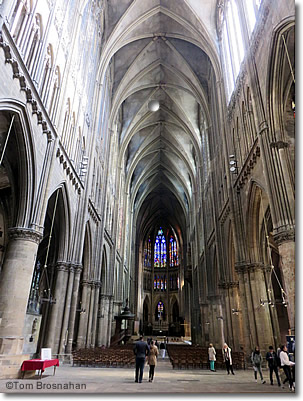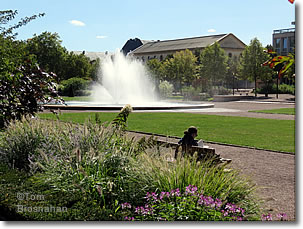 |
Guide to Metz, France | |
| This ancient city on the Moselle River in northeastern France is now a high-tech hub, but its magnificent cathedral still ranks as No. 1 in the world for stained glass. | ||
|
|
|
Metz (pronounced mess), is a city (population 120,000) in northeastern France at the confluence of the Moselle and Seille rivers, 331 km (206 miles) east of Paris, 165 km (103 miles) northwest of Strasbourg, and only 62 km (39 miles) south of Luxembourg City (map). Although noted today as a center of high-tech research and development, automotive industry and metallurgy, Metz has extensive parks and gardens, a long and rich history of 3000 years and several superb cultural monuments. What to See & DoThe city's Cathédrale de Saint-Étienne de Metz has the largest expanse of stained glass in the world, and one of the loftiest naves. The Basilica of Saint-Pierre-aux-Nonnains, dating from the 300s AD, is said to be the oldest church in France. A medieval bridge castle from the 13th century, named Germans' Gate (French: Porte des Allemands), is a landmark. Remains of the citadel from the 16th century and fortifications built by Louis de Cormontaigne are still visible. In addition, Metz boasts the oldest working opera house in France, and the Centre Pompidou-Metz museum of modern and contemporary art. TransportationLuxembourg Airport (LUX), 72 km (45 miles) due north (map), is the closest international airport, served by shuttle buses from the Gare de Metz-Ville (main train station). Lorraine Airport (Aéroport Metz-Nancy-Lorraine, ETZ) in Goin, 23 km (14 miles) south of Metz, serves regional flights. More... The grand Gare de Metz-Ville has fast train connections to Luxembourg, Nancy, Paris (Gare de l'Est), and Verdun. Shuttle buses connect it to the Gare de Lorrain TGV station 22 km (14 miles) to the south. More... The A3, A4 and A31 autoroutes connect Metz with Luxembourg, Paris, Reims, Verdun, and Saarbrücken, Germany. More... Where to StayAs a major crossroads, cultural and commercial center, Metz has plenty of hotels. More... A Bit of HistoryFounded by Celts, conquered by the Romans, Metz was later capital of the Kingdom of Lotharingia, then a semi-independent city of the Holy Roman Empire, and later the Republic of Metz. After the Franco-Prussian War (1871), Metz was transferred to the German Empire, and the Kaiser worked to make it a German city, rebuilding the southern part of the historic city center in German Empire architectural style—even using a different, darker stone than the light yellow Jaumont limestone traditional Metz building stone to make sure everyone knew that Metz had once again changed hands. Transferred back to France after World War I, Metz was claimed as German again (1940) by the Third Reich, but reclaimed for France by the US Third Army (General Patton) in November 1944. So you'll see German influence in Metz, less than 50 km (31 miles) from the German border, which makes the city all the more interesting.
|
|
Nave of Metz Cathedral,
|


